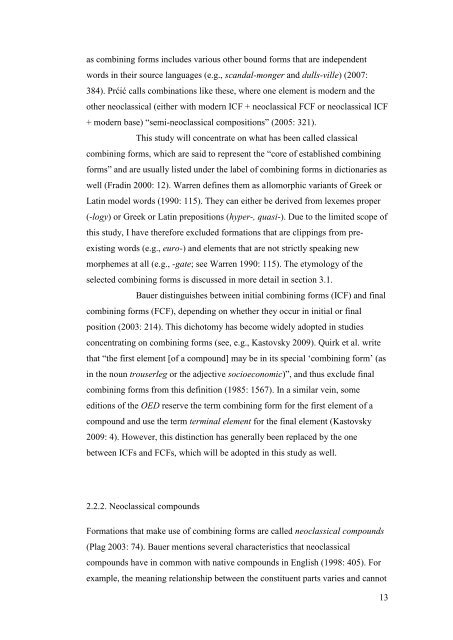The morphological productivity of selected ... - Helda - Helsinki.fi
The morphological productivity of selected ... - Helda - Helsinki.fi
The morphological productivity of selected ... - Helda - Helsinki.fi
Create successful ePaper yourself
Turn your PDF publications into a flip-book with our unique Google optimized e-Paper software.
as combining forms includes various other bound forms that are independent<br />
words in their source languages (e.g., scandal-monger and dulls-ville) (2007:<br />
384). Prćić calls combinations like these, where one element is modern and the<br />
other neoclassical (either with modern ICF + neoclassical FCF or neoclassical ICF<br />
+ modern base) “semi-neoclassical compositions” (2005: 321).<br />
This study will concentrate on what has been called classical<br />
combining forms, which are said to represent the “core <strong>of</strong> established combining<br />
forms” and are usually listed under the label <strong>of</strong> combining forms in dictionaries as<br />
well (Fradin 2000: 12). Warren de<strong>fi</strong>nes them as allomorphic variants <strong>of</strong> Greek or<br />
Latin model words (1990: 115). <strong>The</strong>y can either be derived from lexemes proper<br />
(-logy) or Greek or Latin prepositions (hyper-, quasi-). Due to the limited scope <strong>of</strong><br />
this study, I have therefore excluded formations that are clippings from preexisting<br />
words (e.g., euro-) and elements that are not strictly speaking new<br />
morphemes at all (e.g., -gate; see Warren 1990: 115). <strong>The</strong> etymology <strong>of</strong> the<br />
<strong>selected</strong> combining forms is discussed in more detail in section 3.1.<br />
Bauer distinguishes between initial combining forms (ICF) and <strong>fi</strong>nal<br />
combining forms (FCF), depending on whether they occur in initial or <strong>fi</strong>nal<br />
position (2003: 214). This dichotomy has become widely adopted in studies<br />
concentrating on combining forms (see, e.g., Kastovsky 2009). Quirk et al. write<br />
that “the <strong>fi</strong>rst element [<strong>of</strong> a compound] may be in its special ‘combining form’ (as<br />
in the noun trouserleg or the adjective socioeconomic)”, and thus exclude <strong>fi</strong>nal<br />
combining forms from this de<strong>fi</strong>nition (1985: 1567). In a similar vein, some<br />
editions <strong>of</strong> the OED reserve the term combining form for the <strong>fi</strong>rst element <strong>of</strong> a<br />
compound and use the term terminal element for the <strong>fi</strong>nal element (Kastovsky<br />
2009: 4). However, this distinction has generally been replaced by the one<br />
between ICFs and FCFs, which will be adopted in this study as well.<br />
2.2.2. Neoclassical compounds<br />
Formations that make use <strong>of</strong> combining forms are called neoclassical compounds<br />
(Plag 2003: 74). Bauer mentions several characteristics that neoclassical<br />
compounds have in common with native compounds in English (1998: 405). For<br />
example, the meaning relationship between the constituent parts varies and cannot<br />
13
















